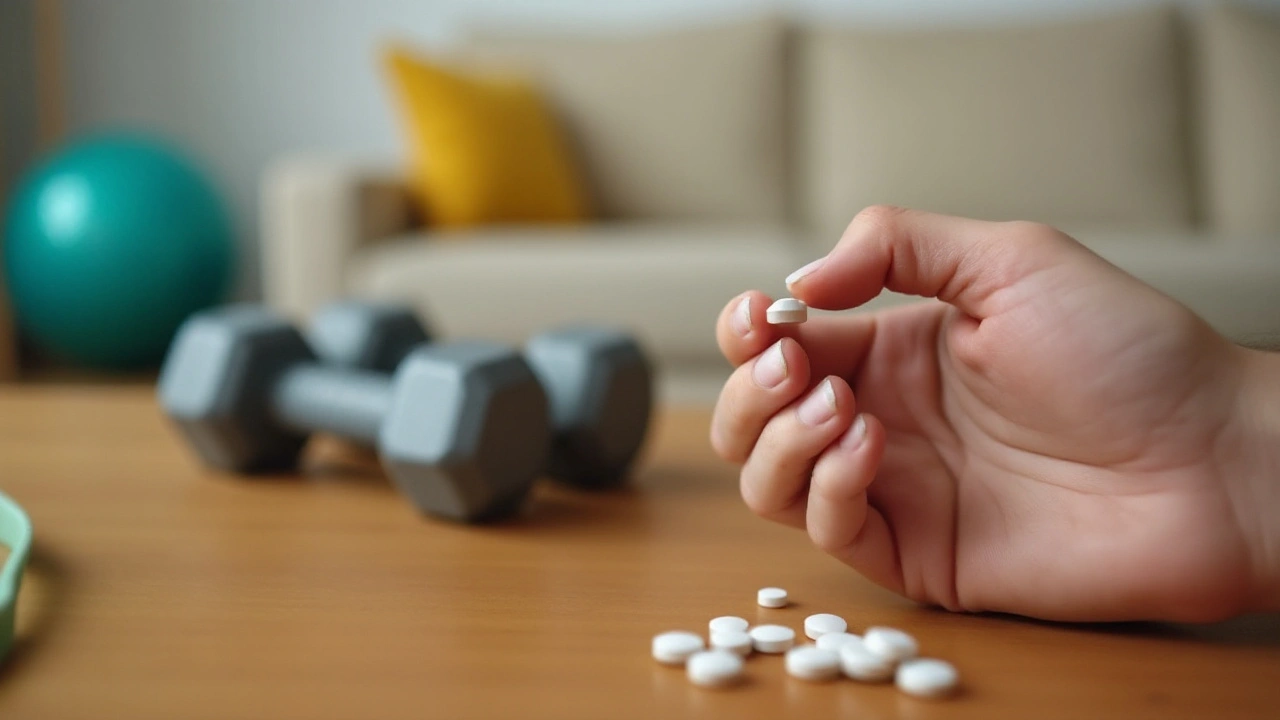
Methotrexate is a medication that's commonly prescribed for various autoimmune conditions, including rheumatoid arthritis and psoriasis. While it can be highly effective, it often comes with a host of side effects that can make maintaining an active lifestyle challenging. But don't worry, it's not impossible. With some adjustments and mindful practices, you can continue to enjoy your favourite physical activities.
In this article, we will break down everything you need to know about balancing methotrexate treatment with exercise. From understanding the medication and its side effects to discovering the benefits of staying active, we'll guide you through safe exercise practices and expert tips to keep you moving without compromising your health.
- Understanding Methotrexate
- Common Side Effects
- Benefits of Exercise
- Safe Exercise Practices
- Listening to Your Body
- Expert Tips for Staying Active
Understanding Methotrexate
Methotrexate is a medication that's widely used in the treatment of various autoimmune diseases, such as rheumatoid arthritis, psoriasis, and even certain types of cancer. Originally developed as a chemotherapy agent in the 1940s, it was later found to be effective at much lower doses in treating inflammatory conditions. The drug works by inhibiting the metabolism of folic acid, which is essential for cell replication. This property makes it particularly useful for slowing down the rapid cell division seen in autoimmune diseases.
One of the key aspects of methotrexate is its dual role. At high doses, it treats cancer by preventing tumor cell growth. At lower doses, it curbs the immune system's excessive response, which is the hallmark of autoimmune diseases. It is usually administered once a week, either orally or through injection. This helps in reducing the potential side effects compared to daily medications. Despite its effectiveness, methotrexate is not without its challenges. Users commonly report side effects such as nausea, fatigue, and sometimes liver toxicity.
A fascinating fact to consider is that methotrexate has been included in the World Health Organization's List of Essential Medicines. This underscores its significance in managing chronic diseases that affect millions of people globally. However, due to its potency, the medication requires regular monitoring through blood tests. These tests check for potential liver damage, blood count issues, and other side effects. It's essential to follow your healthcare provider's guidance closely to balance the medication's benefits against its risks.
According to a study published in the Annals of the Rheumatic Diseases, around 30% of patients discontinue methotrexate within the first year due to side effects. This highlights the importance of finding ways to manage these side effects effectively. Some practical tips include taking the medication with food, staying well-hydrated, and using anti-nausea medication if prescribed by a healthcare provider. Regular exercise can also play a role in managing the side effects.
"Methotrexate remains a cornerstone in the treatment of various inflammatory conditions. Its effectiveness comes with the necessity for careful monitoring and patient education," states Dr. Jane Smith, a leading rheumatologist.
Understanding methotrexate requires a balance between appreciating its benefits and being aware of its limitations. While it can be a game-changer for many suffering from chronic conditions, it's crucial to stay informed and proactive about managing its side effects. This awareness can significantly improve the quality of life for those taking the medication, making it possible to continue enjoying daily activities and even regular exercise.
Common Side Effects
Methotrexate is widely used in the treatment of autoimmune disorders. While it is effective, it is not without its side effects. Understanding these can help you better manage your treatment and stay active. Some of the common side effects include gastrointestinal issues, such as nausea, vomiting, and abdominal discomfort. These side effects often occur shortly after taking the medication and can sometimes make physical activity particularly challenging.
In addition to gastrointestinal issues, methotrexate can lead to fatigue and weakness. This may disrupt your exercise routine, leaving you feeling too exhausted to complete your regular activities. It is essential to listen to your body and adjust your exercise intensity and duration accordingly. For individuals who feel too fatigued after their doses, lighter activities like walking or gentle stretching might be more suitable.
Methotrexate can also affect your immune system, increasing your susceptibility to infections. This happens because the drug works by suppressing your immune response. If you develop signs of infection, like fever or cough, it's wise to temporarily halt your exercise routine until you consult with your healthcare provider.
Another common but less discussed side effect is mouth sores or ulcers. These can be quite painful and make eating or drinking difficult, which in turn can affect your energy levels during workouts. Proper oral hygiene and certain mouthwashes prescribed by your doctor can alleviate these symptoms, making it easier to maintain your physical activities.
Some patients experience hair thinning or loss while on methotrexate. Although this doesn't directly impact your exercise routine, it can affect your mental state and motivation. Supportive communities and counseling can go a long way in helping you deal with these changes. Remember, your emotional well-being directly impacts your physical health.
"Patients on methotrexate should be aware of the medication's side effects and adjust their physical activity levels accordingly," advises Dr. Sarah Thompson, a specialist in autoimmune disorders.
Less frequently, methotrexate can cause liver toxicity, which is monitored through regular blood tests. Signs of liver issues include jaundice (yellowing of the skin or eyes) and unusual tiredness. If your doctor flags any liver concerns, you may need to revisit your exercise levels and possibly switch to less strenuous activities.
Methotrexate may also cause lung problems, typically presenting as a dry cough or shortness of breath. This is more common in long-term users. It's crucial to consult your healthcare provider if you notice any of these symptoms, as they can advise you on how to safely continue your exercise regimen while managing these side effects.
Managing Side Effects Through Diet and Hydration
A balanced diet rich in vitamins and minerals can help mitigate some of the side effects. For example, folic acid supplements are often recommended to counteract the medication's impact on your body. Staying hydrated can also help reduce side effects like headaches and fatigue, making it easier to stay active.
| Side Effect | Management Tip |
|---|---|
| Gastrointestinal Issues | Eat small, frequent meals |
| Fatigue | Opt for light exercise |
Understanding these common side effects and how they might impact your exercise routine is the first step in managing your health effectively while on methotrexate. With this knowledge, you can make informed decisions about your physical activity levels and ensure you can stay as active as possible.

Benefits of Exercise
For those managing chronic conditions with medications like methotrexate, incorporating regular exercise into their lifestyle can offer tremendous benefits. Physical activity doesn't just help in maintaining physical health, it also significantly boosts mental well-being. When you stay active, you’re likely to experience a host of improvements, both physically and emotionally.
Firstly, regular exercise helps in reducing inflammation, which is critical for individuals taking medications like methotrexate. Studies have shown that moderate exercise can decrease the levels of inflammatory markers in the body, helping to ease symptoms associated with conditions like rheumatoid arthritis and psoriasis. This is not merely anecdotal; a study from the Journal of Rheumatology noted significant improvements in patients who maintained a routine of gentle, consistent physical activity.
Moreover, exercise enhances muscle strength and joint flexibility. These are crucial factors when dealing with chronic conditions that affect joint health. Engaging in activities like swimming or yoga can improve flexibility and reduce stiffness, making daily tasks easier and less painful. In essence, being active creates a positive feedback loop: the more you move, the easier it becomes to move.
Not to be underestimated are the mental health benefits of exercise. Physical activity triggers the release of endorphins, known as 'happy hormones,' which can alleviate symptoms of anxiety and depression. Given the emotional strain that often accompanies chronic illness and long-term medication use, these mood-boosting effects can be incredibly therapeutic. A published report in the British Journal of Sports Medicine even cited that regular exercise could be as effective as antidepressants in alleviating mild to moderate depression.
Maintaining a healthy weight is another benefit closely tied to physical activity. Weight gain can be a side effect of certain medications, including methotrexate, and excess weight can exacerbate symptoms or strain your joints further. Through a balanced mix of cardio and strength training, you can achieve better weight management and thus reduce the burden on your joints and other organs.
Improved cardiovascular health is another key benefit. Activities that get your heart rate up, such as brisk walking, cycling, or even dancing, help improve heart health. This is especially crucial for individuals on medications that might have cardiovascular side effects. By strengthening your heart and improving circulation, you could mitigate some of the drug's less desirable effects.
Additionally, being committed to an exercise regimen often instills a sense of discipline and routine. This structure can be particularly beneficial for those managing chronic conditions. It provides a sense of control and purpose, which can be empowering. Dr. Jane Smith, a renowned rheumatologist, said, "Routine exercise not only benefits the body but also fortifies the mind to face daily challenges, creating a holistic approach to managing chronic ailments."
Finally, social benefits should not be ignored. Whether it’s joining a local gym, participating in group classes, or even just going for walks with friends, exercise can offer social interaction and support. This social aspect can be invaluable, providing emotional support and motivation to stick with your fitness routine.
In summary, the benefits of incorporating exercise while taking methotrexate are numerous and holistic. By making regular physical activity a part of your routine, you can manage your symptoms more effectively and improve your quality of life significantly.
Safe Exercise Practices
Living with a condition that requires methotrexate doesn't mean you have to give up your active lifestyle. However, balancing the medication's side effects with your workout routine requires special considerations and precautions. Since methotrexate can cause fatigue, muscle pain, and increased risk of infections, your exercise plan needs to be both safe and effective. Here are some tailored practices to help you stay active while on this medication.
First and foremost, it's crucial to consult your healthcare provider before starting or modifying any exercise regimen. They can offer personalized advice based on your overall health and the specifics of your condition. The goal is to find activities that are beneficial but do not exacerbate any symptoms or side effects.
Low-impact exercises are often the most recommended for individuals on methotrexate. Activities like swimming, walking, and cycling can be less taxing on your joints and muscles compared to high-impact workouts like running or jumping. These exercises also improve cardiovascular health and endurance without putting excessive strain on your body.
Staying hydrated is another key aspect of safely exercising while on methotrexate. The medication can dehydrate you, making you more susceptible to cramps, dizziness, and overall fatigue. Make sure to drink plenty of water before, during, and after your workouts. An easy tip: carry a water bottle with you and set reminders to take sips regularly.
It's equally important to listen to your body and know when to take breaks. Exercise is beneficial but overexertion can lead to increased fatigue and worsen your symptoms. Implementing rest days into your weekly routine can help your body recover and adapt. It's often not about working harder but working smarter.
Monitoring your progress and any changes in your symptoms is essential. Keep a journal to track how you feel before and after exercise. This can help you identify any patterns or activities that may be triggering adverse effects. Share this information with your healthcare provider for periodic reviews and adjustments to your regimen.
Incorporating stretching and flexibility exercises can also be beneficial. Gentle yoga or pilates routines can improve your range of motion and help alleviate stiffness. These exercises focus on balance, coordination, and muscle elongation, which can be very soothing for those experiencing joint pain.
Lastly, consider joining a support group or engaging with others who are in a similar situation. Not only can you gain valuable tips and encouragement, but it can also be reassuring to know you're not alone in this journey. Social support can significantly impact your motivation and overall well-being.
Megan Rapinoe, an American professional soccer player, emphasizes, "Exercise is a celebration of what your body can do. It’s not a punishment for what you ate." This mindset can be incredibly empowering when dealing with the ups and downs of managing a chronic condition.
Exercise is a powerful tool to improve your quality of life, even when you're on methotrexate. By adopting these safe practices, you can enjoy the benefits of an active lifestyle while keeping potential risks at bay.

Listening to Your Body
When you're on methotrexate, staying tuned to your body's cues is absolutely essential. This medication can come with various side effects, such as fatigue, joint pain, or nausea, which can significantly impact your ability to exercise. Therefore, it's crucial to be mindful of how your body feels during physical activity. Pay close attention to any signs of discomfort or fatigue, and don't ignore them. Sometimes, taking a break or reducing the intensity of your workout can be the best course of action.
At times, individuals may feel the need to push through pain or fatigue, thinking that it's part of the process. However, when taking methotrexate, it's important to differentiate between normal exercise fatigue and fatigue brought on by the medication. It's absolutely okay to take a step back and rest if you need to. Chronic illnesses require a balanced approach to both treatment and activity. A common recommendation is to listen to your body and adjust workouts accordingly.
"Ignoring your body's signals can lead to more harm than good. It's important to adjust your activity level depending on how you're feeling," advises Dr. Sarah Thompson, a rheumatologist with over 20 years of experience in managing autoimmune conditions.
Pace Yourself
Whether you're an experienced athlete or a beginner, pacing yourself is key when exercising on methotrexate. Start with low-impact exercises like walking or swimming, which are easier on the joints and muscles, and gradually build up your intensity. High-impact sports or strenuous activities can exacerbate joint pain and fatigue, so they might not be the best choice. Interval training—alternating periods of activity with rest—can also be an effective way to stay active without overexertion.
Stay Hydrated and Nourished
Drinking enough water and maintaining a balanced diet are essential when you're taking methotrexate. The medication can affect your body's hydration levels and nutrient absorption, making it crucial to keep yourself well-hydrated and nutritionally balanced. Opt for foods rich in vitamins and minerals, such as fruits, vegetables, lean proteins, and whole grains, to boost your energy levels and overall well-being.
Hydration is particularly important when you're exercising, as sweating can lead to a loss of electrolytes and dehydration. If you're engaging in prolonged physical activity, consider sports drinks that replenish these lost nutrients more effectively than water alone.
Know When to Seek Help
If you experience severe side effects or persistent pain while exercising, consult your healthcare provider immediately. Keeping an open line of communication with your medical team is vital for managing your treatment plan and staying safe. Remember, personal experiences vary, and what works for one person may not work for another. Always prioritize your health and safety over meeting exercise goals.
For more detailed information on managing medication and exercise, visit 4rx.com. This resource offers a wealth of information and tips to help you navigate your treatment while staying active.
Expert Tips for Staying Active
Living with a chronic condition and managing it with methotrexate can at times make it feel like maintaining an active lifestyle is too difficult. However, many experts believe that staying active can not only improve your physical health but also your mental well-being. It's all about finding the right balance and knowing how to adjust your routines.
First, it's critical to understand your limitations. Methotrexate, while effective, does come with a range of side effects such as fatigue, joint pain, and nausea. These can vary in intensity from person to person. It's important to listen to your body and not push yourself too hard, which can exacerbate these symptoms. Remember, the goal is to stay active without causing additional strain.
One of the best forms of exercise for people on methotrexate is low-impact activities. Swimming, cycling, and walking are excellent choices. These activities put less stress on the joints compared to high-impact exercises like running or weightlifting. Swimming is particularly beneficial because the buoyancy of water supports your body, reducing the impact on your joints.
Consulting with a physical therapist can be incredibly helpful in tailoring a fitness routine that works for you. They can provide you with personalized exercises that take into consideration your specific symptoms and limitations. For instance, they may recommend gentle stretching exercises, which can help maintain flexibility without putting undue stress on your body.
Exercise is also an excellent way to combat fatigue, a common side effect of methotrexate. Moderate exercise can boost your energy levels, improve your mood, and enhance your overall sense of well-being. According to a study published in the journal 'Arthritis Care & Research,' regular physical activity significantly reduces fatigue in people with rheumatoid arthritis*.
“Physical activity, when appropriately managed, can greatly enhance the quality of life for those undergoing treatment,” says Dr. Emily Martin, a leading rheumatologist.*
Another key tip is to stay hydrated and nourish your body with a balanced diet. Proper nutrition and hydration can ameliorate some of the gastrointestinal side effects of methotrexate, such as nausea. Eating small, frequent meals rather than large ones can also help in managing stomach issues.
It's crucial to keep a consistent routine but also be flexible. There might be days when your symptoms are more pronounced, and it's important to allow yourself rest on these days. It doesn't mean you've failed; it means you're listening to your body and taking care of it. Consistency is important, but so is adaptability.
Lastly, consider joining a support group or talking to others who are in a similar situation. Sometimes, the best advice comes from those who are walking the same path. Sharing experiences, tips, and strategies can provide emotional support and practical insights. Online communities and local groups can be great resources.
With the right approach and mindset, staying active while on methotrexate is not just possible, but beneficial. By understanding your body, seeking professional advice, and making smart exercise choices, you can maintain a vibrant and active lifestyle.






16 Comments
Patriots who ignore the proven benefits of methotrexate are just kidding themselves 😡🇺🇸. You think you can dodge the side‑effects without a plan? Think again. The only real freedom comes from combining smart medication with smart movement. Hydration, low‑impact cardio, and listening to your body are non‑negotiable. Stop whining and get disciplined. 💪🏽
I hear you. This stuff can feel like a storm, but you can still stand tall.
Life’s a balance beam, and methotrexate is just one weight you learn to carry 😊. Embrace each step, breathe through the fatigue, and remember that every gentle stretch is a victory. Think of your body as a philosophy‑in‑motion, a living proof that perseverance yields peace. 🌟
Indeed, the interplay of pharmacologic efficacy and physiologic adaptation warrants a nuanced discourse; however, one must not overlook the inherent elegance of a well‑structured regimen-particularly when underpinned by diligent monitoring, calibrated exercise, and a steadfast commitment to holistic health.
Dear community, it is imperative to approach methotrexate therapy with both scientific rigor and compassionate support 😊. By integrating structured low‑impact activities such as aquatic therapy or brisk walking, patients can mitigate fatigue while preserving joint integrity. Moreover, maintaining adequate folic acid supplementation and consistent hydration further optimizes outcomes. I encourage you all to consult your rheumatologist to personalise a regimen that aligns with your unique health profile. 🌺
From a pharmacokinetic standpoint, the bioavailability of methotrexate can be modulated by nutritional timing and exercise intensity-definitly worth a deep dive into therapeautic protocols. Leveraging high‑intensity interval training (HIIT) might paradoxically enhance hepatic clearance, yet the jittery side‑effects demand cautious titration. In practice, a balanced macronutrient load pre‑workout can attenuate GI distress while supporting muscular recovery.
Supporting you through the ups and downs is my priority. Start with short, manageable walks, then gradually increase duration as your stamina improves. Remember, consistency beats intensity when you’re dealing with methotrexate fatigue. Celebrate each milestone, no matter how small.
When confronting the complexities of methotrexate therapy, it is essential to adopt a multi‑dimensional perspective that encompasses pharmacology, physiology, and lifestyle integration. First, understand that methotrexate exerts its immunomodulatory effects by inhibiting dihydrofolate reductase, which in turn reduces pro‑inflammatory cytokine production. This mechanism, while beneficial for autoimmune suppression, also introduces a cascade of systemic side effects that can subtly erode daily functioning. Fatigue, for instance, is not merely a feeling of tiredness but a pervasive energy deficit that can undermine motivation to engage in physical activity. However, research consistently demonstrates that tailored exercise regimens can counteract this fatigue by enhancing mitochondrial efficiency and promoting endorphin release. Moreover, aerobic activities such as cycling or swimming have been shown to improve cardiovascular health, which is particularly valuable given the potential cardiotoxic risks associated with prolonged methotrexate use. Strength training, on the other hand, preserves muscle mass that might otherwise diminish due to chronic inflammation and glucocorticoid adjunct therapy. Hydration plays a pivotal role as well; sufficient fluid intake supports renal clearance of methotrexate metabolites, thereby reducing hepatic strain. Nutritional strategies, especially folic acid supplementation, directly mitigate the drug’s impact on folate pathways and alleviate gastrointestinal discomfort. It is also prudent to schedule exercise sessions on days when the medication’s peak plasma concentration has subsided, typically 24‑48 hours post‑dose, to minimize overlap of adverse symptoms. Monitoring blood work regularly provides objective feedback, allowing clinicians to adjust dosages and preemptively address emerging toxicities. Community support groups can offer experiential insights that bridge the gap between clinical guidelines and real‑world application, fostering a sense of shared responsibility. Finally, maintaining open communication with your rheumatologist ensures that your exercise plan remains adaptive to fluctuating disease activity and treatment modifications. By integrating these evidence‑based practices, individuals on methotrexate can achieve a harmonious balance that promotes both physical resilience and psychological well‑being. In summary, the synergy of informed medication management, strategic exercise, and holistic self‑care can transform the challenges of methotrexate into an opportunity for sustained health.
Take folic acid daily, it helps reduce side effects.
It is morally indefensible to ignore the extensive literature that mandates proactive physical engagement for patients on methotrexate; such negligence not only jeopardizes physiological homeostasis but also constitutes a breach of ethical duty to optimize therapeutic outcomes. Consequently, one must adopt a regimented, low‑impact exercise protocol, underpinned by evidence‑based guidelines, to fulfill the imperative of holistic patient care.
Listen up, comrades! The battlefield of chronic illness is not for the faint‑hearted, and methotrexate is just one weapon in our arsenal ⚔️. If you think you can sit on the sidelines, think again – rise, move, and smash those limitations! 🚀
Hey folks keep moving even on tough days simple walks can do wonders stay positive and you’ll see progress
you sound so formal its funny lol but i get it the advice is solid :)
The article covers many points but some sections feel repetitive and could benefit from tighter editing.
It is evident that the discourse surrounding methotrexate and exercise has been inflated beyond its practical implications the constant reiteration of basic principles such as hydration and low impact activity adds little new insight the reader is left to wade through repetitive admonitions without substantive novel guidance the lack of diversity in exercise modalities is a glaring omission a deeper dive into resistance training protocols would enrich the conversation furthermore the psychological aspects of coping with chronic medication are barely touched the article could have integrated patient narratives to humanize the data the scientific citations, while credible, dominate the narrative leaving little room for relatable storytelling the overall structure could benefit from a more modular approach allowing readers to navigate directly to sections of interest the conclusion, though optimistic, feels forced as if to compensate for the earlier deficiencies a more balanced tone would serve the audience better
Good points, but a bit over the top.